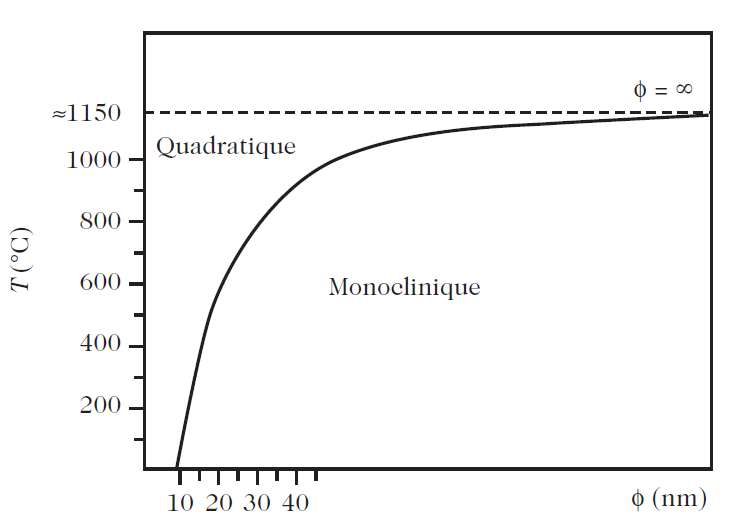
Crystalline Phase Transitions in Nanocrystals
 المؤلف:
C. Br´ echignac P. Houdy M. Lahmani
المؤلف:
C. Br´ echignac P. Houdy M. Lahmani
 المصدر:
Nanomaterials and Nanochemistry
المصدر:
Nanomaterials and Nanochemistry
 الجزء والصفحة:
p39
الجزء والصفحة:
p39
 3-2-2016
3-2-2016
 1630
1630
Crystalline Phase Transitions in Nanocrystals
Phase Transitions and Grain Size Dependence
There are many examples of phase transitions occurring whenever the characteristic dimensions of a material go beyond a certain critical value. More interestingly, such transitions are not restricted to any particular type of material. In the following, we shall give some examples, chosen among ceramics, metals, and also semiconductors.
Ceramics
The grain size dependence of a phase transition in a ceramic can be illustrated by the monoclinic–tetragonal transition occurring in zirconia. This property has been known and exploited for a long time now . At standard atmospheric pressure and room temperature, zirconia crystallises in a monoclinic (low temperature) form, whereas at high temperature, above 1100–1150◦C, its crystal structure is tetragonal. If ZrO2 is in the form of ‘crystals’ of the order of 10 nm, it is the tetragonal form that is stable at room temperature. The transition temperature, somewhere between 1100 and 1150◦C for micrometric crystals becomes lower as the dimensions of the nanocrystals decrease .
In fact it has been shown recently that, for temperatures below those illustrated in Fig. 2.5, the tetragonal–monoclinic transition is still present and occurs for grain sizes of the order of 6.9nm (at 175 K) .

Fig. 2.5. Temperature of the phase transition in zirconia ZrO2 as a function of the
average diameter of nanocrystals in powders at standard atmospheric pressure
Another situation where there is grain size dependence has been established in the case of the Verwey transition, first observed in 1939 by the discontinuous change in conductivity it causes. This transition occurs in magnetite Fe3O4, with the so-called spinel crystal structure. Although there is a wealth of literature on the subject, the mechanisms have not yet been clearly understood. However, a study for nanometric grains has been able to throw some light on the matter . Experiments have also demonstrated a spectacular difference between the temperature predicted for large grains and that observed for nanometric grains (a difference of more than 70 K). It would thus appear that the Verwey transition constitutes another example of grain size dependent phase transition.
 الاكثر قراءة في كيمياء النانو
الاكثر قراءة في كيمياء النانو
 اخر الاخبار
اخر الاخبار
اخبار العتبة العباسية المقدسة


